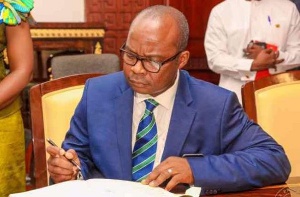Challenges militating against Ghana’s banking system continue to draw concerns from both domestic and international financial institutions and experts.
The latest is from Bretton Woods Institution, the International Monetary Fund (IMF).
The Executive Board of the Fund has asked the Bank of Ghana (BoG) to urgently address rising levels of Non-Performing Loans (NPLs) in the banking sector to forestall a deterioration of the country’s financial sector.
Additionally, the BoG must strengthen its supervisory and regulatory framework of universal banks to address liquidity risks, the Fund demanded in a report it issued after the completion of the Fund’s fourth review of Ghana’s bailout programme.
President Nana Addo Dankwa Akufo-Addo recently charged the Bank to forcefully address current challenges in Ghana’s banking sector in order to guarantee the nation’s financial stability and sustained economic growth.
According to him, it was crucial for the BoG to entrench reputation and credibility in the financial system in order to accelerate government’s transformation agenda.
“My understanding is that a roadmap for addressing banking sector weakness is being implemented. I urge you, as the nation’s Central Bank, to remain committed to the process and to address the challenges confronting the banking sector,” the President stated.
“This will not only guarantee financial stability but also promote greater confidence in that sector”, President Akufo-Addo said
Stock of banks’ NPLs
The stock of NPLs stood at GH¢6.2 billion as at end-December 2016, expanding at a compound annual growth rate (CAGR) of 41.89 per cent from GH¢0.26 billion by end-December 2007.
By the end of June 2017, the stock of NPLs in the banking industry had risen to GH¢7.96 billion from GH¢6.09 billion in June 2016.
The ratio of NPLs to total gross loans (NPL ratio) experienced an increasing trend between 2007 and 2010 from 6.37 per cent to 18.08 per cent and declined to 11.27 per cent in 2014 and thereafter increased to 17.70 per cent in 2016 and 21.2 percent in June 2017.
The NPL ratio reduction from 2011 to 2014 was due mainly to an upsurge in new loans disbursed (i.e. increase in gross new loans) and not because of a reduction in the stock of NPLs.
The Asset Quality Review (AQR) exercise conducted in 2016 also revealed some weaknesses in banks’ credit classification practices, leading to the downgrading of some already-existing credit facilities.
Ongoing efforts by to sanitise industry
IMF’s Directors commended the progress made in the strengthening of Ghana’s banking system, in particular through the approval of time bound recapitalization plans for undercapitalized banks and the recent resolution of two insolvent banks.
The Board welcomed the deceleration in inflation and encouraged the BoG to remain vigilant and take action to bring it back to target.
They also called for measures to further strengthen the credibility of the inflation targeting framework, which would benefit from efforts in the development of the foreign exchange market and continuation of BoG’s policy on zero financing of the government.
High NPLs affect bank lending
Industry experts maintain that NPLs influence bank lending through three interrelated key channels—profitability, capital, and funding.
Bank profitability suffers because high NPLs require banks to increase provisions, which lowers net income, while NPLs carried on banks’ books do not usually generate income streams comparable to performing assets. NPLs, net of provisions, may also tie up substantial amounts of capital due to higher risk weights on impaired assets.
Also a deteriorating balance sheet raises a bank’s funding costs because of lower expected revenue streams and, hence, heightened risk perceptions on the part of investors. Together, these factors result in a combination of higher lending rates, reduced lending volumes, and increased risk aversion.
Poor economic management blamed for the woes of banks
Chief Economist for Africa at Standard Chartered Bank, Razia Khan points out that the major issue with Ghana’s banking system is that over the years there has been great susceptibility and volatility arising from government’s spending cycle.
So in the years when no arrears were being built in the system, the banking system did very well generally but as soon as government arrears started to be a problem it started manifesting itself in rising NPLs related to State Owned Enterprises (SOEs).
“As soon as that cycle can be broken the healthier a banking system Ghana would have; you can’t get away from meaningful fiscal reforms, meaningful public financial management reforms to stop the boom burst that has affected the Ghanaian economy,” she notes
Banks have lamented their exposures to hard hit sectors of the economy such as energy, construction and agricultural sectors which they regretted had adversely affected their asset quality and resulted in rise in NPLs.
Legacy debt
The ruling New Patriotic Party inherited a heavily indebted energy sector with a net debt reaching $2.4billion as of December 2016. About $800 million of the debt is owed to local banks which have threatened their stability and that of the whole financial sector.
Business News of Thursday, 7 September 2017
Source: thefinderonline.com

















